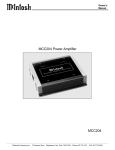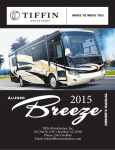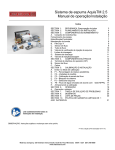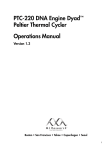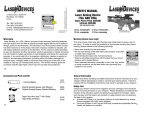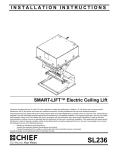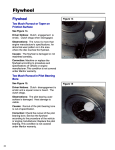Download Directed Electronics 210C Specifications
Transcript
P/N 8-078-927-28 effective 03/25/2005 ELECTRIC MOTORS GEARMOTORS AND DRIVES Installation and Service Instructions for 180-210 C-Face Motors For replacement parts refer to sheet part number 8-078-917-77. Instructions and parts list also available at www.rexnord.com/stearns. Drain plug (WASHGUARD brakes only) Figure 1 (for dimensions see page 4.) Important Please read these instructions carefully before installing, operating, or servicing your brake. Failure to comply with these instructions could cause injury to personnel and/or damage to property if the brake is installed or operated incorrectly. For definition of limited warranty/ liability, contact Leeson Electric Corporation, P.O. Box 241, 2100 Washington Street, Grafton, WI, 53024-0241, (262) 377-8810. Caution 3. To prevent an electrical hazard, disconnect power source before working on the brake. If power disconnect point is out of sight, lock disconnect in the off position and tag to prevent accidental application of power. 4. Make certain power source conforms to the requirements specified on the brake nameplate. 5. Be careful when touching the exterior of an operating brake. Allow sufficient time for brake to cool before disassembly. Surfaces may be hot enough to be painful or cause injury. 1. Installation and servicing must be made in compliance with all local safety codes including Occupational Safety and Health Act (OSHA). All wiring and electrical connections must comply with the National Electric Code (NEC) and local electric codes in effect. 6. Do not operate brake with housing removed. All moving parts should be guarded. 2. Do not install the brake in atmospheres containing explosive gases or dusts. 8. For proper performance and operation, only genuine Stearns parts should be used for repairs and replacements. 7. Installation and servicing should be performed only by qualified personnel familiar with the construction and operation of the brake. 9. After usage, the brake interior will contain burnt and degraded friction material dust. This dust must be removed before servicing or adjusting the brake. DO NOT BLOW OFF DUST using an air hose. It is important to avoid dispersing dust into the air or inhaling it, as this may be dangerous to your health. a) Wear a filtered mask or a respirator while removing dust from the inside of a brake. b) Use a vacuum cleaner or a soft brush to remove dust from the brake. When brushing, avoid causing the dust to become airborne. Collect the dust in a container, such as a bag, which can be sealed off. 10. The motor should not be run with the brake in the manual release position to avoid overheating of friction disc(s). Figure 2 LEESON ELECTRIC P.O. BOX 241 A Subsidiary of Regal-Beloit Corporation 2100 Washington Street Grafton, WI 53024-0241 U.S.A Remove screws, conical spring washers (142W), and flat washers (142X). General Description The 87,700 Series coupler is a spring-set, electrically released, self adjusting brake. The double C-face allows the brake to directly couple a C-face motor to a C-face gear reducer. Or, for in-line application, the brake can be mounted directly to a foot mounted C-face motor, using the bearing mounted output shaft as an in-line drive shaft. Note: Coupler brake is designed for in-line applications only. Do not apply overhung or side load to brake output shaft. E. Remove pressure plate (5), friction disc (4) and stationary disc (3). F. Attach endplate (2) to NEMA C-face of motor using four 1/2-13 socket head cap screws and medium spring lock washers (not supplied) torque per manufacturer’s specifications. (Head of cap screws must not project above friction surface.) Note 4: If motor, with or without reducer, is to be ceiling mounted after assembly, entire brake will have to be rotated 180° or upside down so it will be positioned with solenoid plunger (29) above frame when final assembly is mounted on ceiling. Similarly, for horizontal wall mounting, rotate 90°. I. Installation Procedure Note 1: Check face of motor to which brake is to be mounted, to be sure NEMA dimensions of 0.004″ T.I.R. on concentricity and face run out are met. Shaft run out is to be within 0.002″ T.I.R. Maximum shaft end float is 0.020″. Use standard length NEMA shaft. G. Reassemble friction discs (be sure friction discs slide freely, file I.D. if necessary), springs (if vertical), stationary discs, and pressure plate in correct sequence and position. All parts must slide freely. The universal mounting pressure plate presently used has three tapered reliefs on outboard face. Note 2: The effectiveness of the dust-tight waterproof brake enclosure depends on a fully enclosed motor C-face as the brake face is not sealed. A. Remove hub (16) from brake assembly. With key (not furnished) in place on motor shaft, slide hub onto shaft to 1” (± 1/32”) of standard motor C-face. Tighten the three set screws over the motor shaft to 290 in-lb (on single disc brake, the set screw over the keyway should be tightened to 87 in-lb). Note 5: Brakes with a single friction disc do not have stationary discs. Vertically mounted brakes will have springs to separate stationary discs (except one disc vertical below). Note color coded sequence of springs (figures 2A, 2B, & 2C) for proper assembly of vertical mounting components. Note 3: On most applications, particularly in H. Mount support plate assembly, torque screws to 50 in-lbs in endplate. Conical spring washer installed under the screw head. Flat washer used under the conical spring washer only with aluminum support plate. Be sure that assembly is mounted with the solenoid in a vertical position (plunger above frame) as shown when brake is horizontal. If plunger is not tied down and has allowed the mechanism to overadjust, it will have vertical position, a set screw dimple drilled into shaft is recommended. B. Remove housing bolts (15), lock washers (15W) and housing (7). C. Depress solenoid plunger (29) and tie plunger to frame (79). D. Remove entire support plate assembly (142) by evenly unscrewing screws (142S). 1 1 3 Description Blue Vertical Push-in Spring Figure 2A 2 Friction Discs - Vertical Above Item No. No. Req. 1 2 1 3 Plain Vertical Push-in Spring 2 3 Red Vertical Push-in Spring 2 J. See Section on Electrical Connection of Brake. K. Assemble housing and shaft assembly, rotating shaft (35) to engage key (35K) into hub keyway. Be sure housing is assembled with manual release on right hand (solenoid) side (looking at output shaft side) or release lever (148) will not latch. Replace housing bolts and tighten evenly to 118 lb-ft of torque. L. Remove access plug (7P). Insert a 3/16″ hex wrench and tighten the two set screws to 290 in-lb. (set screws are located 120° either side of the keyway). M. For reducer application, mount and secure brake/motor combination to mounting face of reducer. For alignment when brake shaft is direct-connected to another shaft by a coupling refer to coupling manufacturer′s suggested procedure. Side or overhung load is not permitted. Consult factory for reversing applications. CAUTION 1: Inverter Motor and Special Control Systems. This brake contains a single phase AC coil that requires instantaneous power within ± 10% of rating at the coil. A separate power source is required when this brake is used in conjunction with a motor or control system that limits voltage or current input (i.e. inverter motors) or causes a ramping of the power supply. or pinched, and that leads will not be rubbed by friction disc, trapped between solenoid plunger and frame, caught between lever arm and endplate, or by linkage. Note 2: See figure 3 for dual voltage coil connection and connect to any two leads of single or three-phase motor of the same voltage. The brake can also be wired to external switch contacts providing proper voltage other than that used to control the motor. Normally, the motor and brake contacts are interlocked. Endplate 2 Friction Discs - Vertical Below Item No. No. Req. Repeat this process several times to set air gap on solenoid. (Check Self-Adjust Maintenance Section for proper gap measurement, or corrective action for improper gap.) Note 1: Be sure lead wires to coil are not tight Description Figure 2B 1 I. Remove plunger tie-down. Manually lift solenoid plunger to maximum travel and release. Complete electrical connections, (See Section on Electrical Connection of Brake.) Depress solenoid plunger manually or electrically, and allow it to snap up. II. Electrical Connection of Brake 1 Friction Disc - Vertical Above Item No. No. Req. to be reset before mounting support plate. In this case the lever arm throat will be near, or touching, the pinion teeth. Refer to Self-Adjust Maintenance. Loosen pressure spring cap screw (19) until pressure spring (11) is free, mount support plate assembly to endplate, and retighten spring cap screw until snug. Do not overtighten! Torque to a maximum of 100 in-lbs. Description 1 3 Blue Vertical Push-in Spring 2 3 Red Vertical Push-in Spring Figure 2C 2 Note 3: To use a 230 volt coil (or a 230/460 dual voltage coil connected for 230 volts) with a 230/460 dual voltage three-phase motor, the brake leads are connected across two motor terminals as shown, or other equivalent combinations. If a 230 volt brake coil is slightly, or decreased by lowering slightly, wrap spring stop (76). Be sure to retighten (stop) screws (76S). Manually lift plunger to maximum travel and release. Depress plunger, manually or electrically, and allow it to snap up. Repeat several times, then recheck air gap for factory setting of 13/16″ to 15/16″. AC Voltage Coil Connection Class B Coil (black) Note: To measure solenoid air gap on verti- For Power Line A Power Line B Tie Leads Low voltage 1 and 3 2 and 4 – High voltage 1 2 3 and 4 Figure 3 Figure 4 Figure 5 connected as shown in figures 4 and 5 the motor can be operated on either 230 volts or 460 volts with no effect on brake operation. III. General Maintenance Warning! Any mechanism or load held in position by the brake should be secured to prevent possible injury to personnel or damage to equipment before any disassembly of the brake is attempted or the manual release lever is operated on the brake. Observe all cautions listed at the beginning of this manual. Note 1: Replacement part kits for many items are available and contain retrofit instructions. Note 2: Do not lubricate any part of the brake as this may cause a malfunction and/or loss of torque. A. Coil replacement All standard NEMA AC voltage coils are available in kits. Select coil kit from appropriate replacement parts list for the particular brake series being serviced. B. Friction disc replacement Note: Replace friction discs in single disc brakes when wear surface area is one half the original disc thickness (1/4″). In multiple disc brakes, replace all friction discs when throat of lever arm is within 1/16″ of touching teeth of pinion. C. Self-adjust maintenance Since the self-adjust brake automatically adjusts itself for friction disc wear, maintenance is held to a minimum. The solenoid is factory set with a 13/16″ to 15/16″ air gap, and requires no resetting, even when changing friction discs. The gap is determined by the position of wrap spring stop (76). Should air gap change, follow the steps listed below: 1. If (stop) screws (76S) had been loosened and retightened, the air gap may require resetting. The gap is measured between mating surfaces of plunger (29) and solenoid frame (79), and may be increased by raising cally mounted brakes, grasp solenoid link to hold plunger in a free horizontal position and move toward solenoid frame until spring pressure is felt. Holding firmly in this position measure air gap between mating (ground) surface on solenoid frame and solenoid plunger. Adjust to proper gap as directed in Self-Adjust Maintenance. Check gap by again holding plunger as directed. 2. Tang of wrap spring must be below, and must make contact with, wrap spring stop (76) when solenoid lever Air (28) is manual- gap ly raised. If stop is bent outward, allowing tang to bypass it, rebend to square posiFigure 6 tion, assemble correctly, and reset solenoid air gap as described in Paragraph 1. 3. Should air gap have decreased or disappeared, the solenoid lever and pinion assembly (8) may have become contaminated due to lubrication or residue as a result of overheating of brake. For reference purposes refer to Figure 7. Tang A should align with the centerline of hole B. Use kit #5-66-7371-00 if replacement is necesFigure 7 sary. 4. Check condition and positioning of pinion and rack assembly. Replace parts as necessary with complete assemblies. D. Solenoid lever and pinion assembly replacement If pinion teeth are worn, replace entire assembly. Consult appropriate parts list for kit number. Check sector gear of lever arm for wear. If sector gear teeth of lever arm are worn, replace entire lever arm assembly available as a kit from appropriate repair parts list. Also check pinion teeth for wear. E. Drain plug removal (WASHGUARD brakes only) If moisture has accumulated inside the brake enclosure, remove the drain plug (location shown in Figure 1). Replace plug after fluid has drained. IV. Troubleshooting A. If brake does not stop properly or overheats, check the following: 1. Is manual release engaged, and is motor energized? 3 2. Friction discs may be excessively worn, charred or broken. 3. Hub may have become loose and shifted on shaft. 4. Is hub clean and do friction discs slide freely? 5. Are controls which govern start of brake cycles operating properly? 6. Are limit switches, electric eyes, etc. functioning properly? 7. On vertically mounted brakes, are springs in place in disc pack? See P/N 8-078-937-06. 8. Have mounting faces loosened? 9. Pressure spring may be improperly assembled or broken. 10. Is solenoid air gap adjusted correctly? (See Self-Adjust Maintenance, Section III, Item D.) 11. Check linkage for binding. The approximate pressure applied to the top of the solenoid link to move plunger is: #5 coil 3 lbs #6 coil (15 lb-ft) #6 coil (25 lb-ft) #8 coil 5-1/2 lbs 9 lbs 16 lbs If excessive force is required, determine cause of binding and correct. Do not overlook bent, worn or broken plunger guides as a possible cause for binding. 12. Solenoid lever stop (22) must be in place on support plate. 13. Solenoid may not be energizing and releasing the brake. Check voltage at the coil and compare to the coil and/or nameplate voltage rating. 14. A voltage drop may be occurring. If excessive drop in voltage is noted, check wire size of power source. Correct as needed. Note: A method to check voltage at coil is to insert a block of wood of the approximate thickness of the solenoid air gap between the solenoid frame and plunger. (The block will prevent brake from releasing when coil is energized.) Connect voltmeter leads at the coil terminals or lead wires. Energize coil. Voltmeter needle will not fluctuate and reading can be taken. Reading should be taken immediately and the coil de-energized to prevent over-heating of the coil. Compare voltage reading with coil rating. 15. Check slots of endplate for wear at the areas where stationary discs are in contact. Grooves in the slots can cause hang-up or even breakage of ears of stationary discs. If grooving is noted, replace endplate. 16. Check that heads of mounting bolts do not extend above wear surface of endplate. 17. Check pressure spring length to insure correct compressed height. Approximate original spring lengths are given in the following table so that correct setting may be verified and corrected if necessary. With worn friction discs, add amount of wear to the approximate spring length shown in table. 18. If a heater is supplied and excess rusting has occurred in brake, check power source to heater to be sure it is operating and that heater is not burned out. 19. If stopping time is more than two seconds (rule of thumb) and/or the application is Color Torque (lb-ft) Compressed Spring Length White 15 3-1/4” Orange 25 & 50 3-1/4” Purple 35 3-1/4” 20. Use Loctite ® 242 to secure link screw nut to link screw if vibration causes nut to loosen. B. If brake hums, solenoid pulls in slowly, or coil burns out, check the following: 1. Voltage supply at coil versus coil rating. 1. Check mounting face run out, mounting rabbet eccentricity and shaft run out. See Installation Procedure, Section I, Note 1. Correct as required. 2. Check for signs of the outside diameter of the friction disc(s) rubbing on the inside 3.12 2.62 3.12 2.62 A H 0.19 0.19 0.19 A G 0.44 2.12 A E 2.12 2.12 C 2.62 A 2.81 2 4X 180 2 4X 2 4X 2 4X Dimensions (Inches) 2.81 2.81 Brake Bore & NEMA Shaft Frame Dia. Size (U/X) 3.31 NEMA Enclosure 8.38 175590.00 1087752B31QG C. If brake is noisy during stopping: 210 175588.00 1087742B31QG 175589.00 1087751031QG 9. Excessive voltage drop when motor starts. Check size of lead wires for motor starting current and solenoid inrush current. See Section IV-A, Item 11, 12, 14 and 15. 1-1/8” 1087722B11QG 1087731011QG 1087732B11QG 1087741031QG 8. Sector gear and pinion teeth may be jamming due to excessive tooth wear. 1-3/8” 175584.00 175585.00 175586.00 175587.00 6. Is solenoid dirty? 8.38 8.38 175583.00 1087721011QG 5. Solenoid frame and plunger may be excessively worn. 8.88 Brake Coil Rating (VAC) 230/460 PART NUMBERS 2. Is solenoid air gap excessive? (See Self-Adjust Maintenance.) Stearns Part Number 4. Plunger guides may be excessively worn. Does solenoid plunger rub on solenoid frame laminations? If so, replace plunger guides. 7. Solenoid mounting screws may have become loose, causing frame to shift and plunger to seat improperly. more than five stops per minute, check thermal requirements of load versus thermal rating of brake. Leeson Part Number 3. Shading coils may be broken. 4 diameter of the endplate. This would indicate brake is eccentric with respect to the motor shaft and/or the shaft is deflecting during a stop. Check alignment and shaft diameter. Also check for worn motor bearings. If realignment does not correct the problem, a larger diameter shaft may be required. Shaft deflection may also be caused by excessive overhang of brake from motor bearing. Additional shaft support may be required. 3. Check for bad motor bearings. Replace if necessary. Check for excessive shaft endfloat. Correct as required.




